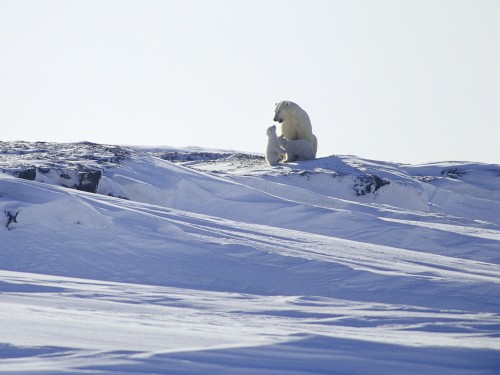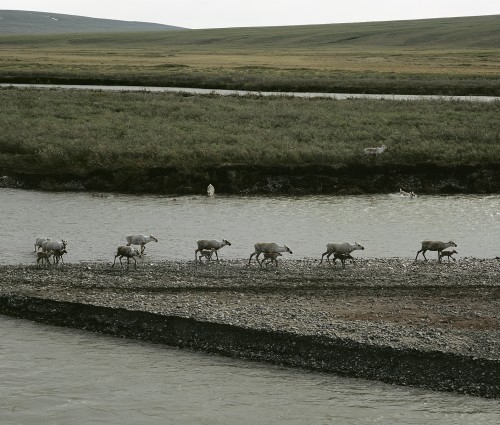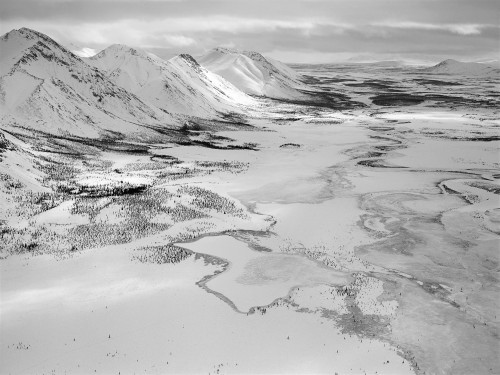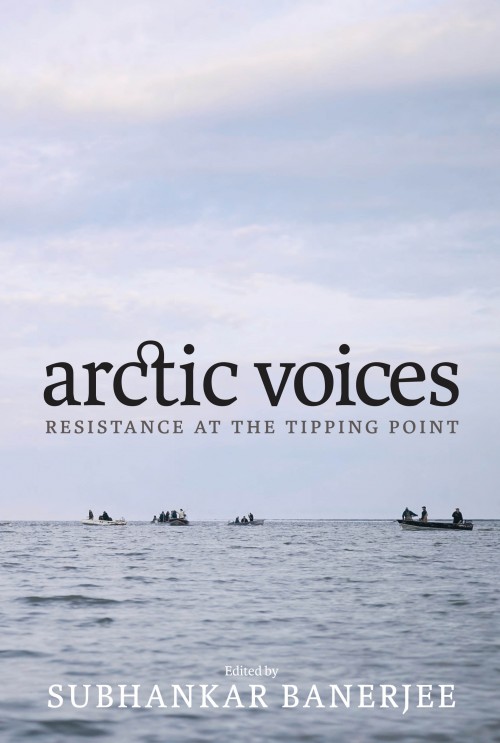Arctic Voices: Subhankar Banerjee promotes wilderness as Shell Oil moves in

As part of our “Nature of Writing” series, Subhankar Banerjee present Arctic Voices June 20 at 7 pm in the Readings Gallery at Village Books in Bellingham; Free!
The coldest places are ravaged by a warming world.
“I describe this as the Arctic paradox,” explorer and educator Subhankar Banerjee said. “The very thing that is devastating the Arctic—global warming—is the result of accumulation of greenhouse gases that we see from the burning of coal, oil and gas. And these are the very resources industry are entering the Arctic to extract and release.”
From his journey and journals, the photographer describes the melting and retreat of sea ice at an unprecedented pace, and the effects of that on the marine ecology. Simultaneously, and magnifying upon the effects, permafrost is melting on the land, freeing tremendous volumes of methane from primordial wetlands, accelerating the release of climate-changing greenhouse gases into the atmosphere. Herds and entire species perish in cycles of thaw and freeze as gales of worsening weather savage the north.
“Because conditions there are so harsh, everything grows very slowly, recovers very slowly,” Banerjee noted. “If you damage the Arctic, it takes a long time to recover. There is a tremendous provision of life there, but it is not like the tropics. It is sparse. It is delicate. We have to understand that and respect that.”

Banerjee’s interest in the Arctic took him into the high latitudes as an amateur observer with a gifted natural eye. He emerged an advocate to professionals in high places.
An engineer by training with masters degrees in physics and computer science, Banerjee came to photography late in life, but showed enough instinctual talent to put together a book soon after he abandoned his science career in full-time pursuit of his art. Arctic National Wildlife Refuge: Seasons of Life and Land, published by The Mountaineers Books in 2003, showed the fecundity of life on the northslope of Arctic Alaska in all four seasons.
The images Banerjee collected over 14 months spent on the Arctic National Wildlife Refuge (ANWR) were dramatic enough to also persuade the Smithsonian National Museum of Natural History to produce an exhibit. Things got interesting for the lowkey Seattle resident.
The Smithsonian exhibit in Washington D.C. went up just as the Senate began debating oil drilling in ANWR, a stated priority for President George W. Bush in his first term. Proponents of drilling in the wildlife refuge went to great lengths to describe the region as a lifeless void: Gail Norton, Secretary of Interior, called it, “a flat white nothingness;” Alaska Senator Ted Stevens described it as “empty… ugly…a barren…frozen wasteland.”

The Smithsonian exhibit down the street from the Capitol gave lie to these descriptions. Banerjee’s images show muskoxen, polar bears, willow ptarmigan, caribou and other creatures inhabiting their ancient niches on the snowy Arctic plains.
California Senator Barbara Boxer understood his quiet message. She held up Banerjee’s book on the Senate floor, highlighting a dramatic picture of a polar bear crossing sunlit sea ice. She recommended everyone visit the display of Banerjee’s “breathtaking” photographs.
The administrative response was disheartening. Banerjee’s work was swiftly, without notice, relocated from the main floor to a more obscure basement gallery, and his informative captions were altered or deleted altogether.
But the Smithsonian’s censorship backfired as international press coverage spread Banerjee’s Arctic photos far and wide, giving them far more exposure than they would’ve received without the political meddling of the Smithsonian. The vote to drill in ANWR failed in the Senate and the lifeways of the Pacific loon, Grizzly bear, Dall sheep, Arctic ground squirrel and buff-breasted sandpiper quietly went on. Yet national policy also went on, and energy directives advanced by Bush proliferate under Obama. These events galvanized Banerjee.
“My photographs were quiet, they touched your emotions,” he said. “Now, with the pace of change, my words must be loud.”

His new book, Arctic Voices: Resistance at the Tipping Point, brings together passionate first-person narratives from more than 30 prominent activists, writers and researchers who address issues of climate change, resource extraction, environmental justice, natural history, ecology and human rights.
The Obama administration has conditionally approved Shell’s plans to drill 10 exploratory wells in the Chukchi and Beaufort seas. Drilling in these remote areas—the first in offshore Arctic Alaskan waters—is seen as risky, especially after the traumatizing BP Deep Horizon disaster in the Gulf of Mexico in 2010.
Arctic Voices calls out against the effort to drill for oil in the far north.
We’ve had an unfortunate stealing of language,” Banjeree explained. “Clean energy advocates talked about reducing our dependence on foreign oil as a means to achieve that goal. This was taken up by the gas and oil industry as a reason to increase domestic extraction, to—in effect—worsen the conditions the phrase originally sought to address.
“Between oil extraction in the Arctic ocean, extractions from the Tar Sands in Alberta, shale oil and shale gas in much of the Western United States, deepwater drilling in the Gulf—and now a new emphasis on coal extraction—all of these have accelerated in recent years. They have not decreased,” he said. “Instead of taking the country to a cleaner energy future, we are taking the country into the next century and beyond into a fossil-fuel driven future.”
Obama’s U.S. Bureau of Ocean Energy Management, Regulation and Enforcement, under the Department of the Interior, declined to pursue an environmental impact statement (EIS) for Shell’s plan to drill exploratory wells. According to the agency, there was “no evidence that the proposed action would significantly effect the quality of the human environment.”
They instead issued a Finding of No Significant Impact.
Not so fast, responded a coalition of 14environmental organizations and a coalition of native Inuit interests known as Resisting Environmental Destruction on Indigenous Lands (REDOIL). In a letter sent to the federal agency overseeing Shell’s drilling plans, they wrote, “The proposed activity threatens a number of significant effects, including effects to endangered Bowhead whales from drilling and ice– breaking noise, effects from a very large oil spill, and cumulative effects, and has the potential to harm subsistence activities that are of central cultural significance to Arctic coastal communities.”
The groups want a full EIS “to analyze and disclose the effects of the proposed drilling.” They maintain this is a clear requirement under the National Environmental Protection Act of 1969.
The letter also points out, “The recommendations of National Commission on the BP Deepwater Horizon Oil Spill also strongly support preparation of an EIS for Shell’s exploration plan.”
Vice Admiral Roger T. Rufe, a 34-year veteran of the U.S. Coast Guard, a former president and CEO of Ocean Conservancy, and former director of operations and planning at the Department of Homeland Security, discusses some of the risks inherent in oil drilling in this remote region:
“The Arctic Ocean has one of the harshest climates on Earth. Even in the summer, conditions are volatile, with sudden violent storms and shifting sea ice. The shoreline is sparsely populated, with no roads connecting the eight main villages to each other or to the rest of Alaska. The nearest major seaport is 1,300 nautical miles away; the nearest Coast Guard air station is 950 air miles. A spill cleanup effort could take weeks to mount and then could suffer endless delays because of foul weather.”
“Hard questions need to be asked about any oil company’s ability to mount a response to a major oil spill in hurricane-force winds, high seas, broken and shifting sea ice, subzero temperatures, and months of fog and darkness,” Marilyn Heiman, director of the Pew Environment Group’s Arctic program, told the New York Times.

“The Beaufort and Chukchi Seas are remarkable marine sanctuaries,” Banerjee writes. “They’re home to estimated 10,000 endangered Bowhead whales, estimated 3,600 to 4,600 threatened polar bears, more than 60,000 Beluga whales, Pacific walrus, three species of seals, numerous species of birds and fish, and various tiny creatures all the way down to the krill that makes much of that marine life possible.”
On May 25, 2012, a three-judge panel of the 9th Circuit Court of Appeals issued a unanimous decision upholding the Obama Administration’s permitting process, bringing Shell’s drilling plans one step closer tofruition. Further appeals are pending in federal court.
The New York Times reports, “Shell has already invested nearly $4 billion on its 10-year offshore leases and preparations for exploration in the forbidding Chukchi and Beaufort Seas. Its current plan is to drill up to 10 exploratory wells in the two seas, potentially leading to production by the end of the decade.”
Originally published in the Cascadia Weekly June 6, 2012. Editor Tim Johnson provided assistance with this story.

